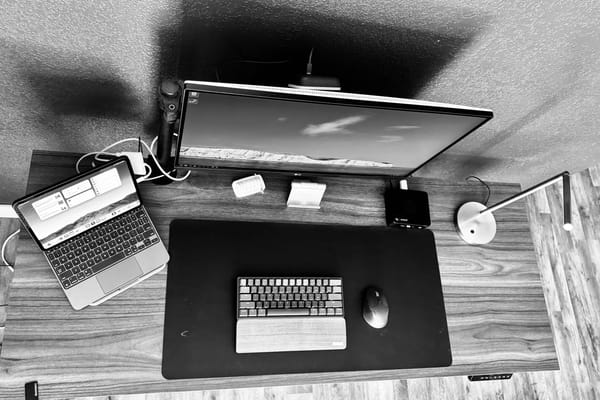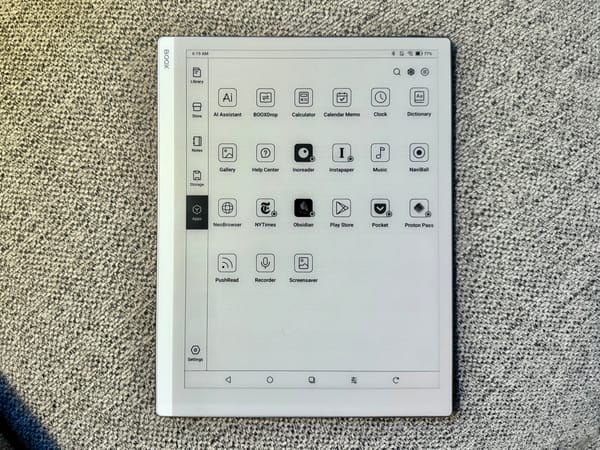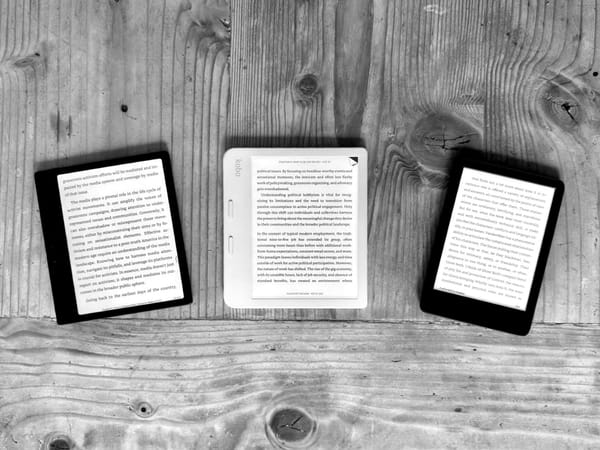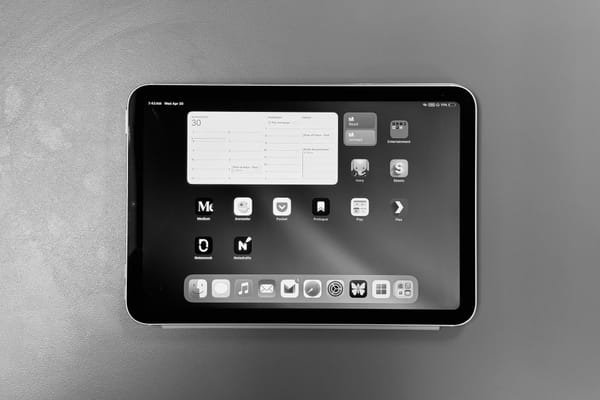How I Use My iPad Mini

It has become my almost everything device.
My love for the iPad Mini has never faltered, but my need for one was always confusing. You see, I have come to realize that the iPad Mini has always been the perfect device for me, except I never had a setup that allowed it to be what I needed to be most - my everything (else) device.
If you read my last post, Back To The iPad For Good, you know that I now have two iPads as part of my setup; a 12.9-inch iPad Pro and an iPad Mini 6. Because I love iPadOS so much, I got frustrated by trying to make the iPad Mini do everything, since I preferred using it over other devices - most times a Mac but sometimes a Windows laptop too.
The frustration didn’t come from me feeling that iPadOS was gimped, which some people poorly try and argue. Instead, I wanted to use iPadOS, but the size of the Mini always left me wanting more. Though it is perfect for quick tasks or doing something on the go, but for more intensive tasks, I prefer to have something larger to tackle it.
Now that I have my preferred OS on a larger computer for those more intensive tasks, that leaves room for the Mini to breathe and be a more flexible device without the baggage of needing to be more. I can still do most things that my larger iPad can do on the Mini, but this isn’t about capability but a preference on the size of device and the context of what I want to do on each.
With all that said, let's talk about my iPad Mini and how I have set it up. Before I get into the details of how I use the Mini, I should first go over what I have. Again, I mentioned this in my previous post, but instead of a base model 6th generation in Space Gray that I bought, what was sent to me was a Starlight model with cellular and 256 GB of storage. I was greatly surprised by the upgrades and didn’t realize how much I was going to actually love them, especially cellular.
Home Screen
I try to keep my iPad pretty simple when it comes to widgets and icons on the home screen. I have another home screen that I will touch on later, but for my main I just have a Calendar, a widget stack with Weather and News widgets, and a shortcuts widget for reading — again something I will go over later.
I have the Fluted Gradient wallpaper by the BasicAppleGuy and for my apps I have the following:
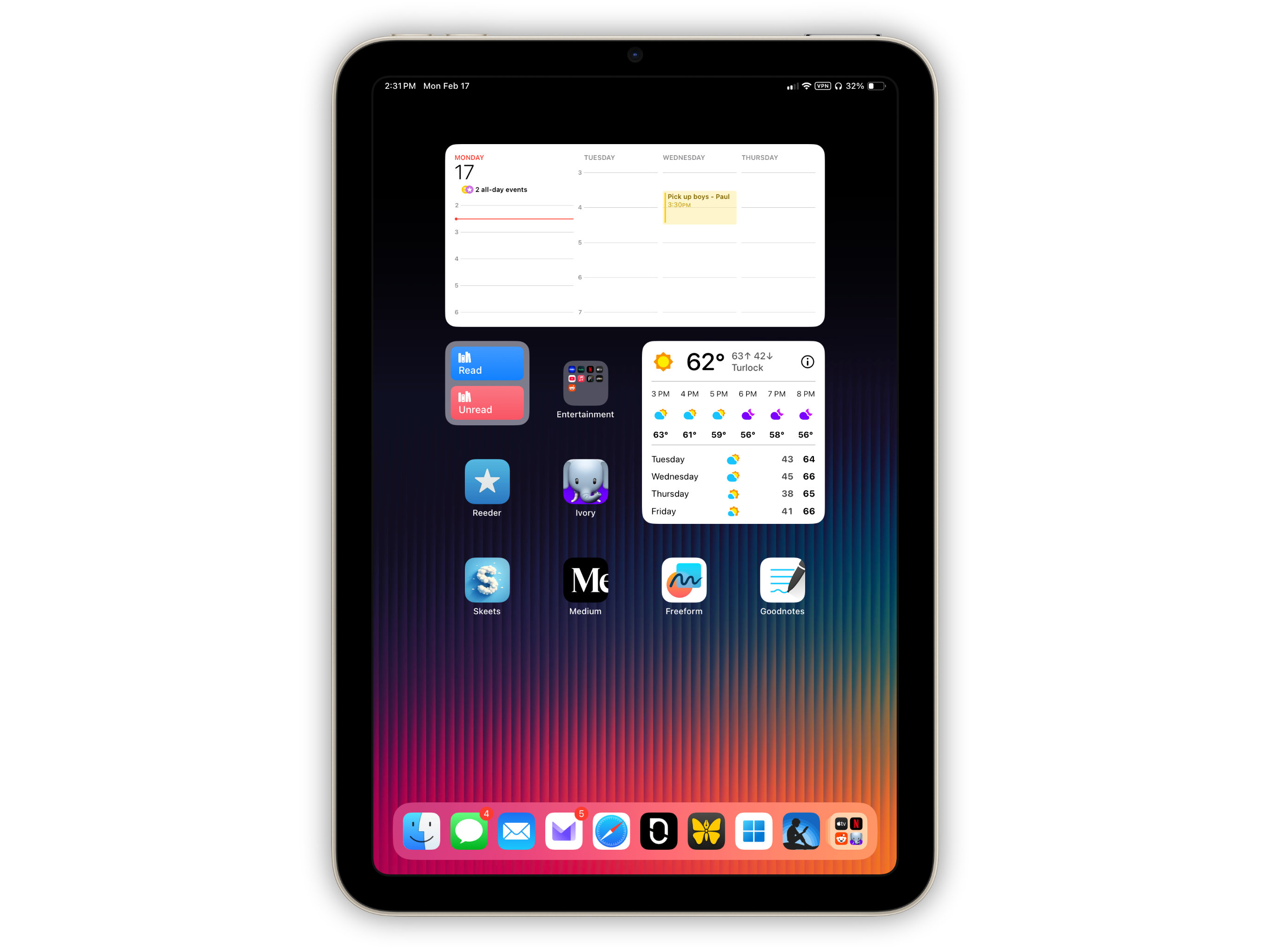
Home Screen
- Reeder (RSS Reader)
- Ivory (Mastodon Client)
- Skeets (Bluesky Client)
- Medium
- Freeform
- GoodNotes
- Entertainment Folder
- Streaming apps
- YouTube
Dock
- Files (with a custom Finder icon using shortcuts)
- Messages
- Mail (Business\everything-else email)
- Proton Mail (Important email)
- Safari
- Notesnook (Preferred notes app)
- Ulysses (Best writing app)
- Windows (RDP Client)
- Kindle (also a custom icon using shortcuts)
A couple of notes on the apps I am using; I found Notesnook from Ben Brooks and I love it so much. I use it on everything including on Windows and it works great, I honestly can’t believe it is free and open-sourced. I am thinking about hosting the sync server myself making it even more secure than it already is.
If Bluesky comes out with an iPad version of the official app, I will replace it with Skeets. Skeets is fine, but I really like the Bluesky app and would just prefer that. Ultimately, I don’t care too much about my home screen, I use Spotlight and the App Library a lot and I am constantly rotating apps on my home screen.
My Favorite eReader
I have struggled to find the best way to read books. I love reading books, and because I am a geek, it can sometimes be a struggle to find the right device. I really like the single-use (for the most part) e-ink tablets like the Kindle line because they do take me away from all my other tech and help me focus on just reading.
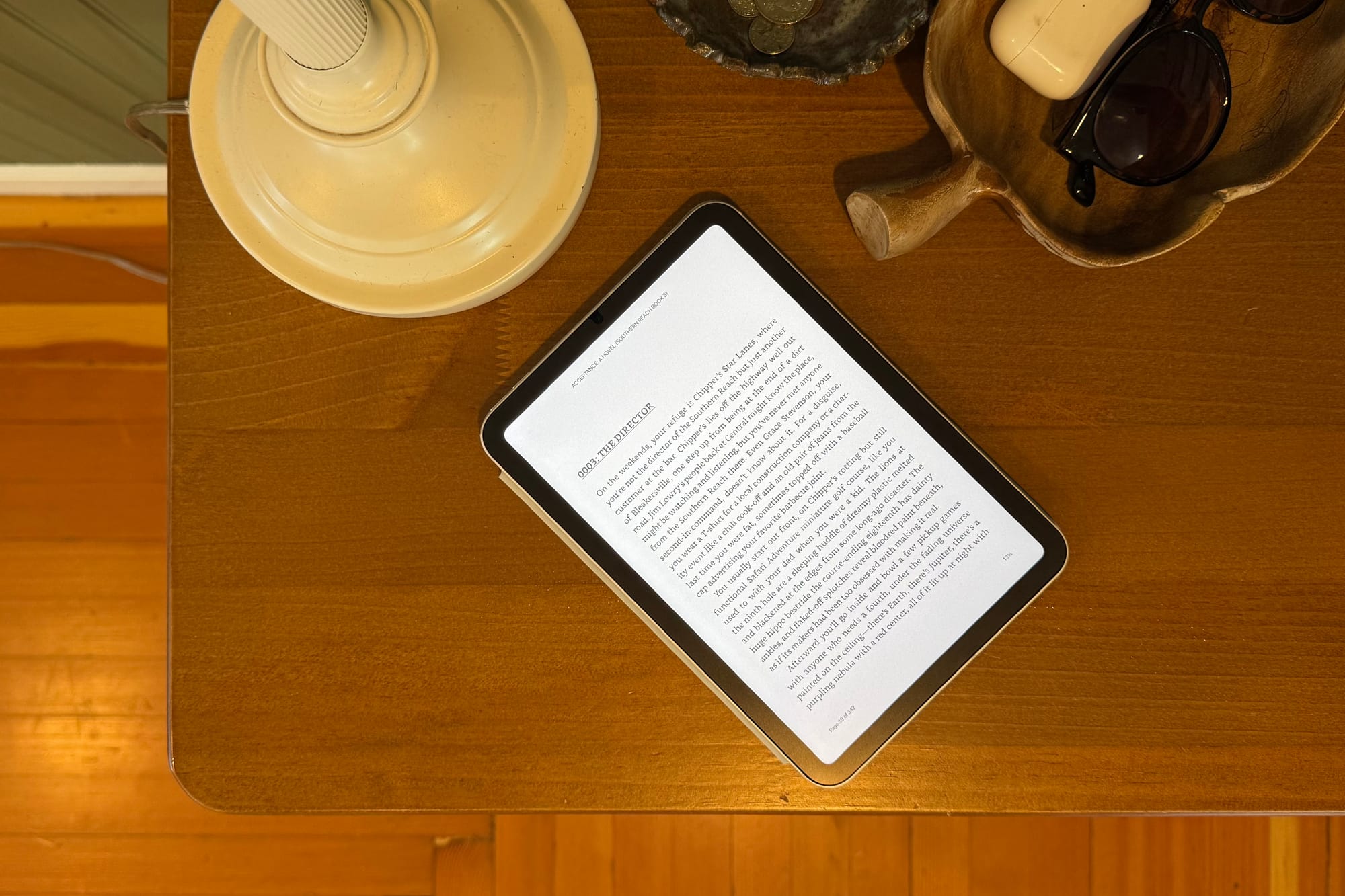
The problem is that I am also very invested in the Kindle ecosystem, so I have a lot of books and audiobooks in my Kindle library. This is because of Whispersync and just the platform I started using when I jumped into digital books, so my library has grown a lot over the years.
Still, even though I like some of the Kindle devices that are available, I have struggled to find the perfect one for me. My favorite of all time was the Kindle Voyage because it had a smaller footprint, one of the first models to have a flush screen, and the most important feature: physical buttons to turn pages - they were capacitive but still offered a physical way of turning pages without having to touch the screen.
The Boox Palma has always tempted me, and I may try one out eventually, but the cost of it has always deterred me from taking the plunge. I also have tried the Boox Air, which I liked, but reading a Kindle Android app on an e-ink display is a bit weird, and I didn’t enjoy it enough to justify its cost either — the Kindle app on the Palma also makes me wary.

So, I decided to take the iPad Mini and transform it into my own eReader when I wanted to sit and read. Before I made these changes, I will say that I love reading on the iPad Mini. It is the perfect size to hold in my hand for long periods to read anything: RSS, books, news, and even social media apps like Bluesky and Mastodon.
As an eReader, I always found reading on the iPad Mini great, but I wanted to make some changes to take it to the next level. Not only to make my reading experience better, but to try and establish that this iPad Mini I want to be a device I use to read books first and foremost. After reading the really long fan-fiction, Mancled, and the first two books of the Southern Reach trilogy, I have to say it is going great.
There are three parts that I did to turn my iPad Mini into a more focused eReader:
- Custom Reading Home Screen
- Reading Focus and Shortcuts
- Matte Screen Protector
Custom Reading Home Screen
Creating your own home screens has been available for a while for iPhones and iPads, but I never really utilized it too much. Sometimes I would create a Watch home screen that had all my streaming apps available but instead just turned that into a folder on my main screen. But for reading, I really wanted to do something that felt intentional.
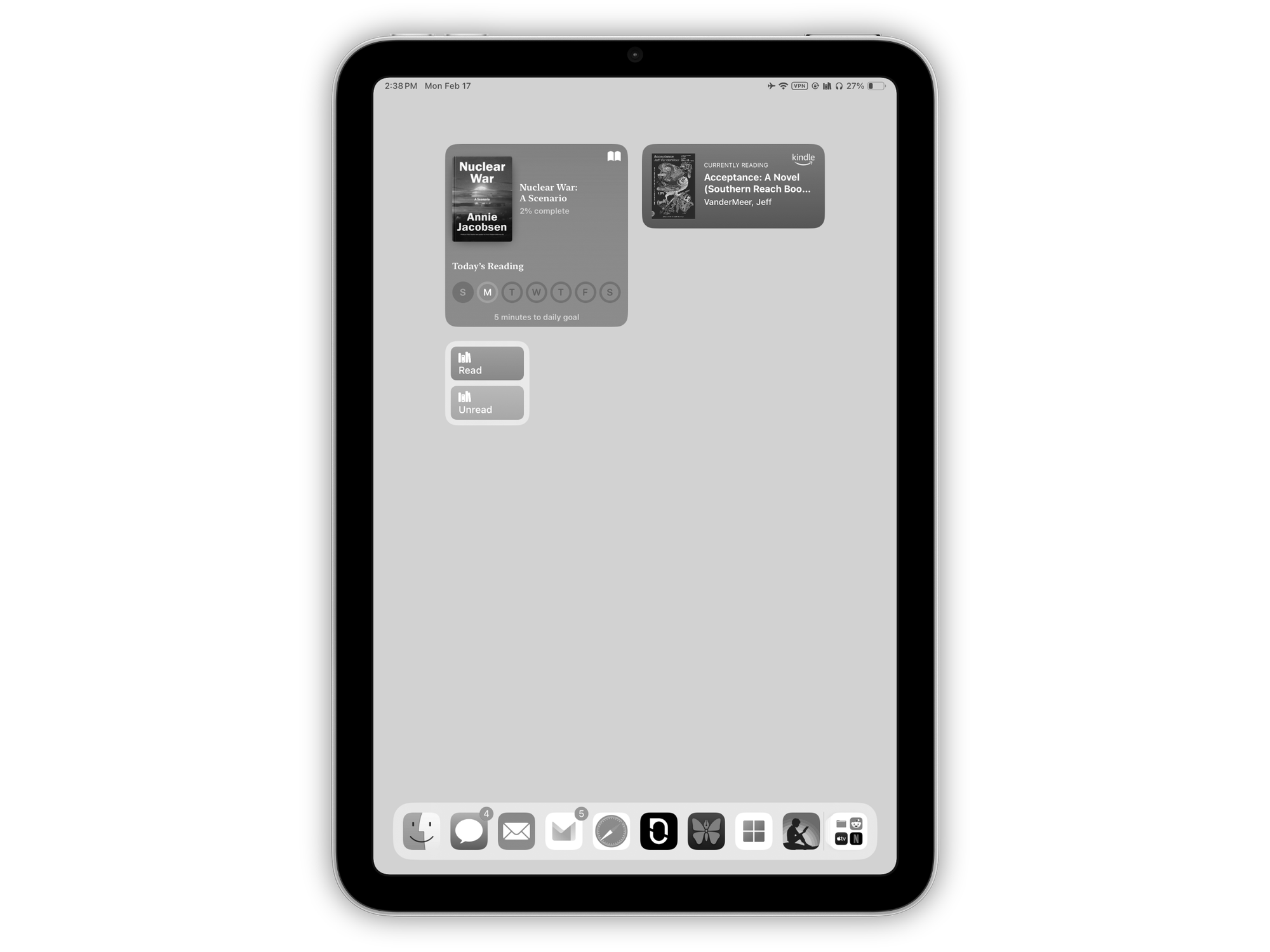
So I created a new home screen with my reading apps that I wanted and a new shortcut widget that is in the same place on my main home screen and reading home screen. I will go over the shortcut next, but the main things that I did on my reading home screen are just two widgets; Apple Books and Kindle. It also has a plain light gray wallpaper as the background.
Not much else to this home screen. The more fun parts are what the shortcuts do, and that’s the point. I needed this to be a space of just me deciding to read without the distractions of other apps or widgets to pull me away. I have mostly been using the Kindle app, but I plan to read some Apple Books that I have not read yet too.
Reading Focus and Shortcuts
Now for my shortcuts, they are also pretty simple but also really helpful to get me in the mode of reading. First, I created a Reading Focus that allows no notifications and set my custom reading home screen to it. This Reading focus will be the trigger to automate other settings that I have Shortcuts for.
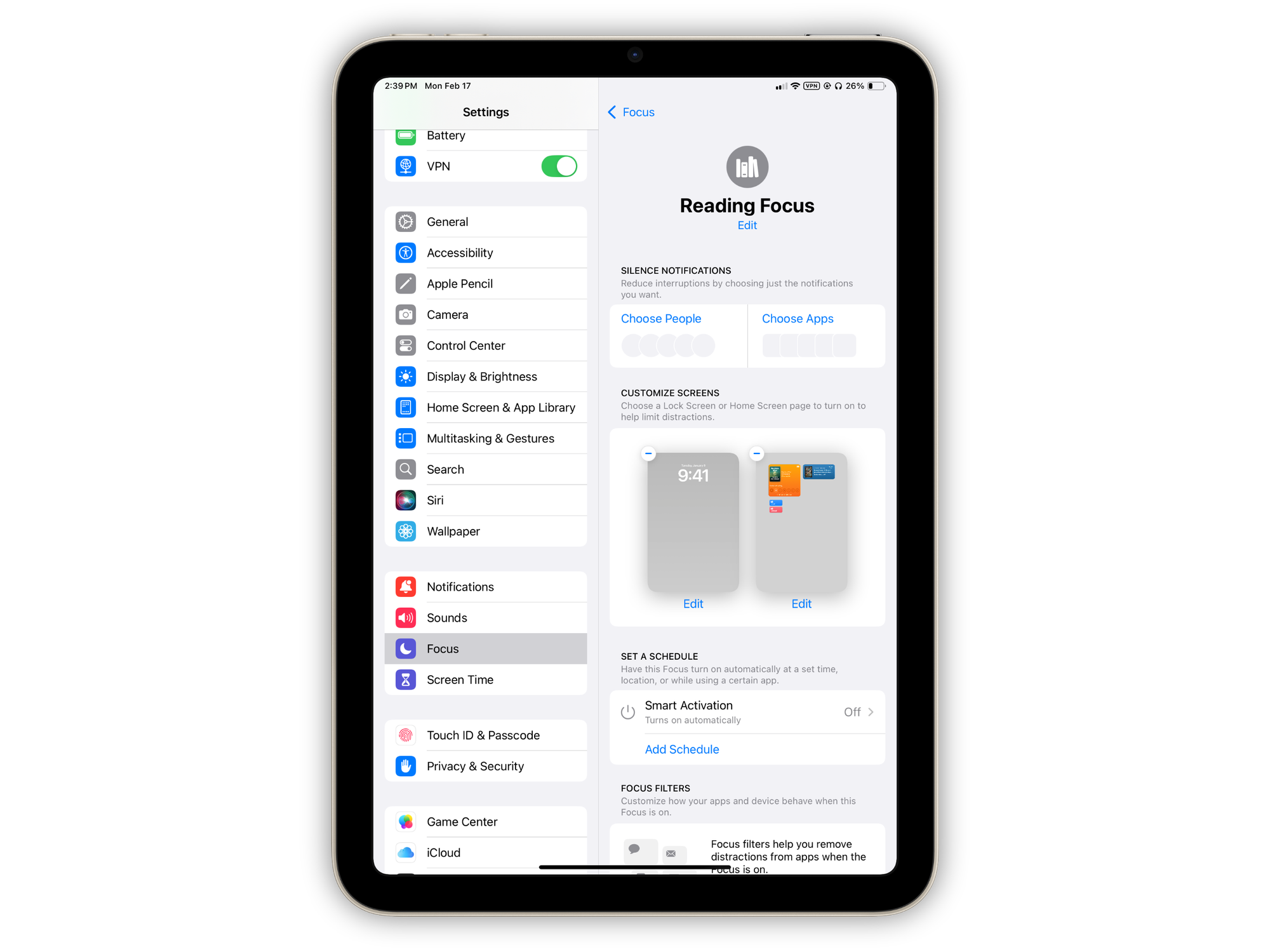
I first created two Shortcuts called Read and Unread, and all these shortcuts do is set the Reading Focus on and off. Then I put both of those shortcuts onto my home screen to easily toggle between the two. Pretty straightforward so far, but I also wanted to turn on a couple of other settings, and this is where automation in Shortcuts comes in.
In the Automation section of Shortcuts, I have one for when the Reading Focus is set and when the Reading Focus is turned off. The automation for the focus turning on does three things: turn color filter on (turning the iPad display into grayscale), turn on Airplane Mode, and toggle Orientation lock to portrait. The Automation for Unread does the opposite of these actions.
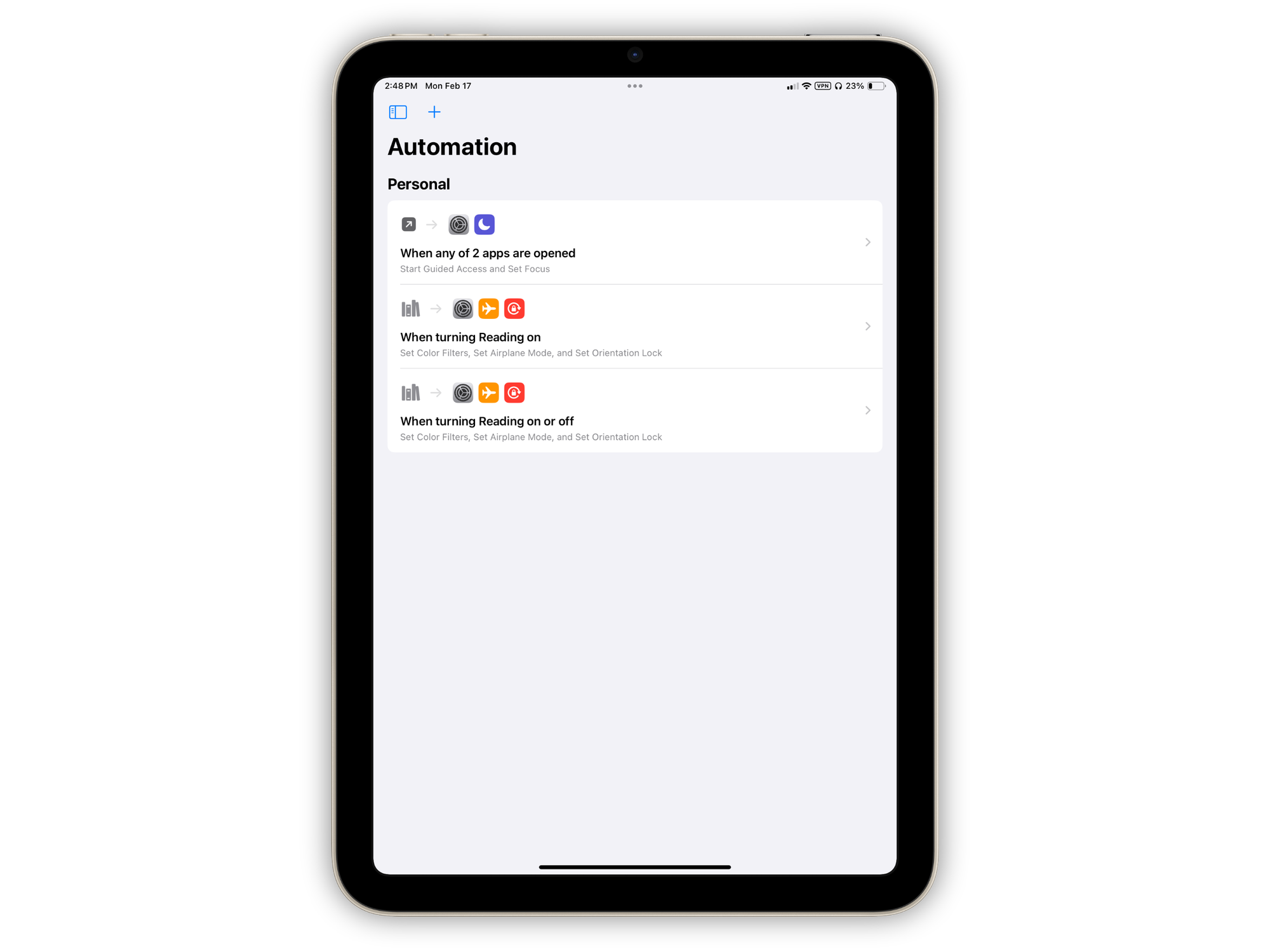
Making these settings gives me the best experience to just read. The screen going gray scale makes it feel like an e-ink display, the Airplane Mode prevents me from being tempted to jump out and look something up or go into another app, and the orientation lock makes it so when I am reading on my side in bed, it stays in portrait mode.
I could just stop here, but I also have one (really two) more automations that I set up in Shortcuts for when I open the Kindle app (or Apple Books app). Not only does the Kindle app being opened cause all the things I listed above to happen, but it also turns on Start Guided Access so I can’t swipe home or leave the app without triple-clicking the home button and putting in a six-digit pin.
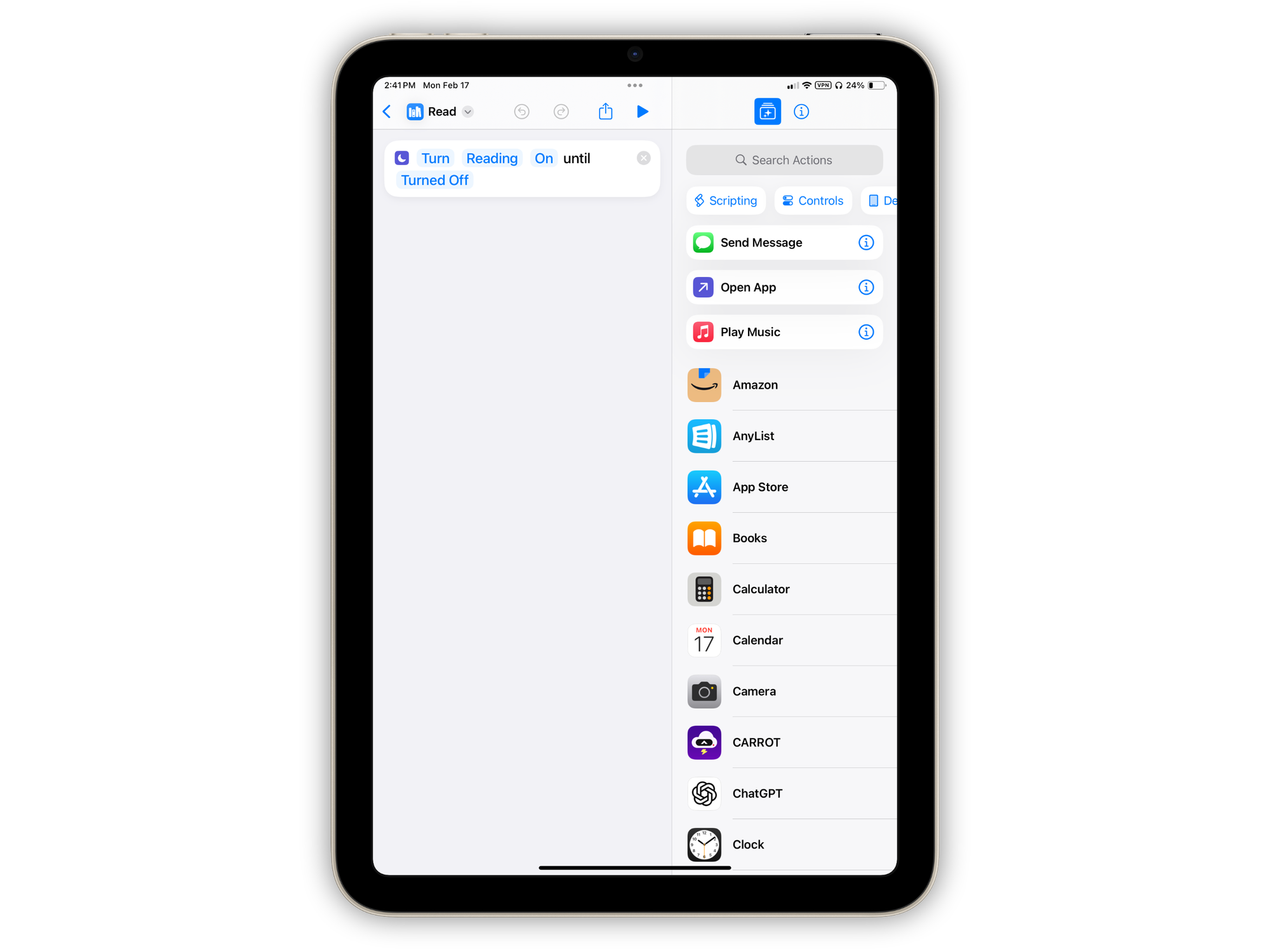
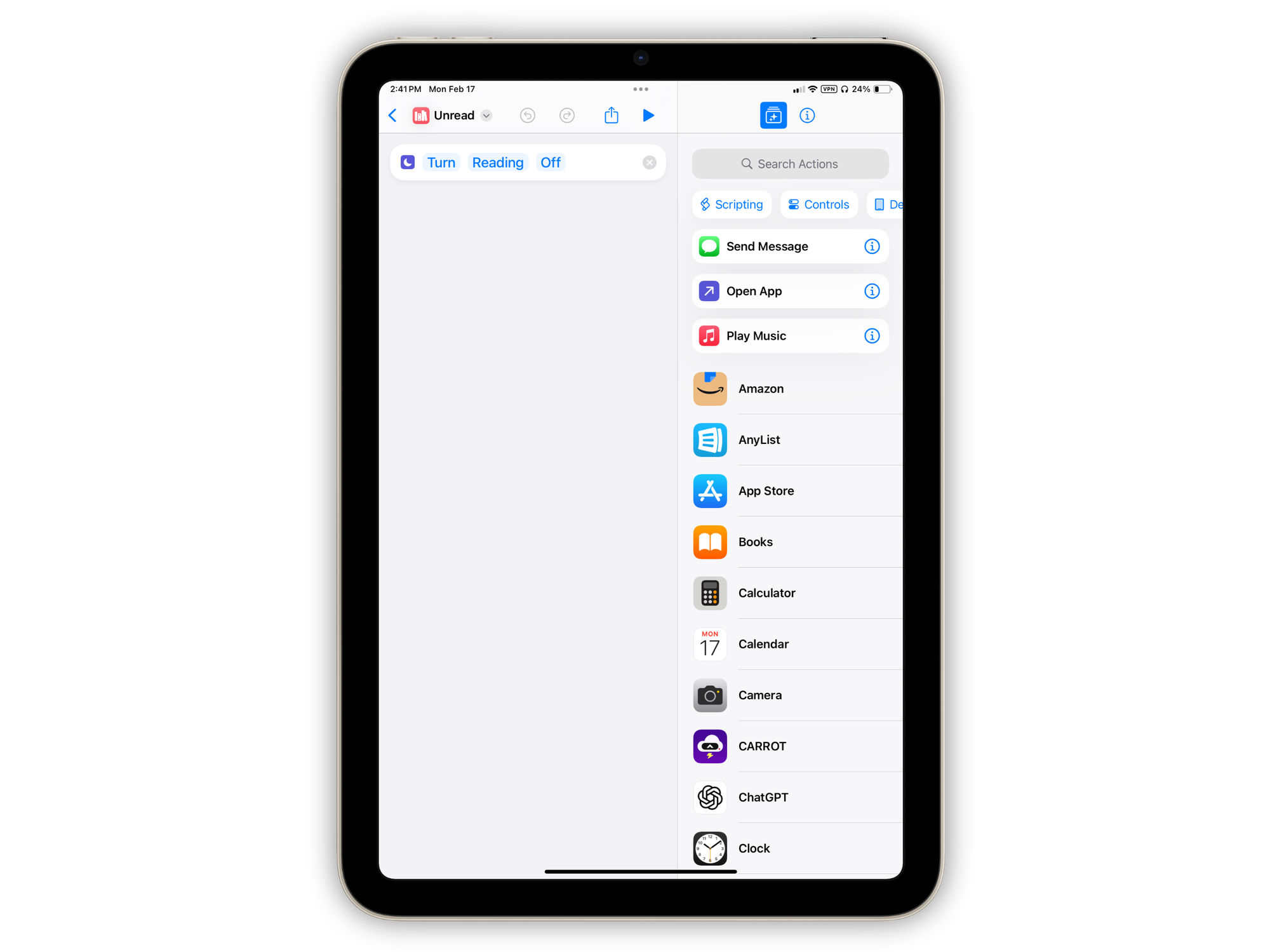
Read and Unread Shortcuts.
The pin is only six zeros, but it provides an extra step of me preventing myself from leaving and focusing on reading. So whether I click on the Read shortcut on my home screen or open the Kindle app, all of these things happen to get me into reading mode. And so far, like I mentioned before, it has been working great. I have already read some books and am about to finish the last book of the Southern Reach trilogy before diving into the new surprise book that was released last year — I guess I have to stop calling it a trilogy.
Matte Screen Protector
This one is pretty self-explanatory, but I also got a screen protector for the Mini to help give me that e-ink experience. It is nowhere near the same experience as a Kindle or other e-ink device, but it does help some with glare when I read outside. Plus, the matte display just looks good with the grayscale in the Kindle app.

Like I said though, it isn’t perfect. When I was on a cruise recently, I tried reading on the top deck with the sun directly above me, and the glare was just too much even with the matte screen protector. Maybe a Kindle would be better in that scenario, but the iPad Mini was unreadable.
I will say that I constantly go back and forth with screen protectors on the Mini. I have come to hate any screen protectors that try and give you a paper-like experience. Not only do I feel like they do not feel like paper, but they also cause way too much distortion of the screen that it drives me nuts. The screen protector I got does not promise a paper-like feel, just a thin plastic matte sheet keeping the clarity of the display still pretty great.
Since Amazon’s recent announcement that they will stop allowing users to download the books they purchased from the Kindle store, I realized it was time to move on. I know I will really miss the Whispersync, but it is insulting that Amazon would try and take away the ability to have the books I purchased and use them anywhere I damn well please.
So I went through the process of tediously downloading every ebook I have and started the process of transferring them to Apple Books. Even though I am going to miss some of the features that the Kindle ecosystem offers I am also excited about all the new doors opening too.
Now that I have my books free from a closed system I now have the ability to read them anywhere. I have been wanting to try out the new features in Apple Books so I am looking forward to making that my exclusive reading app, but now I have the ability of also moving those books to another eReader in the future.
I have been tempted to try out the Kobo e-ink devices and this now allows me to not have to start over and bring my library of digital books over. I also plan to look for new places to buy ebooks like bookshop.org which now offers the ability to buy ebooks from independent bookshops.
Cellular
With regard to cellular, it just so happened I was listening to a conversation on a recent episode of ATP, where Marco answers a listener question on why he and Casey really want a cellular option for the Mac. I have always been on the side of the listener in this situation, in that tethering from my iPhone has always been the reason why I never opted for cellular and only went for WiFi iPad models.
This changed once I started using my iPad Pro more out of the house. One example that Marco gave as to why having a cellular Mac is ideal was the iPhone. When you are on your iPhone at home doing something that requires an internet connection, as you leave your house, the cellular network automatically takes over when you leave your WiFi. The same thing happens when you are using your phone’s cellular data service and connect to WiFi automatically when walking into your house.
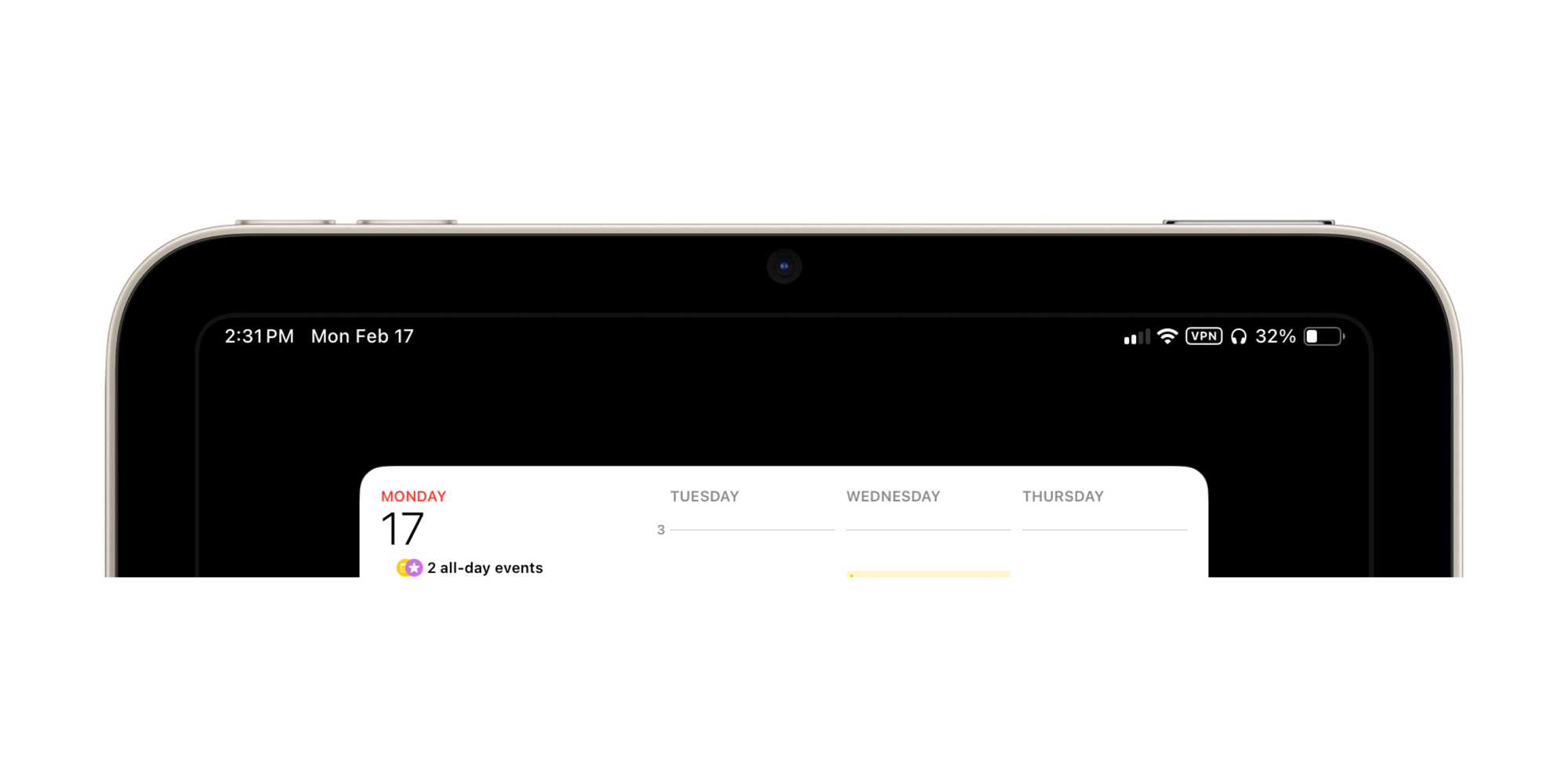
This back-and-forth hand-off of always having an internet connection to your devices is a great feature, and it makes sense for a device in your hand. It wasn’t until I started using the iPad Mini with cellular that I also understood the appeal for your computer, especially on devices like the iPad where it doesn’t automatically connect to your phone when you are no longer on WiFi.
When I walk into my house with my iPad, whether it is asleep or not, it connects to the WiFi automatically (and even if it doesn’t connect while asleep, I wouldn’t know since it connects to the WiFi so quickly when I wake it up). This same thing does not happen on a WiFi-only iPad and your iPhone’s hotspot. Every time I decide to lock my iPad and walk away for only a few seconds, when I unlock it, I have to go through the same steps of reconnecting back to my iPhone’s hotspot again.
In saying all that, I am planning on always getting cellular now for my devices if they are available. I don’t plan to upgrade my iPad Pro anytime soon, but if I do, I will definitely get cellular included and activated since the iPad Mini has shown me how valuable it is to have.
Handwriting
The iPad Mini is also a great brainstorming device. I have decided to embrace the digital notebook experience and I have been trying to use more apps with the Apple Pencil. Right now I still use GoodNotes for journaling but I am in search of another. I just really don’t like all the clutter in the header, I would prefer a more plain, clean canvas to write on.
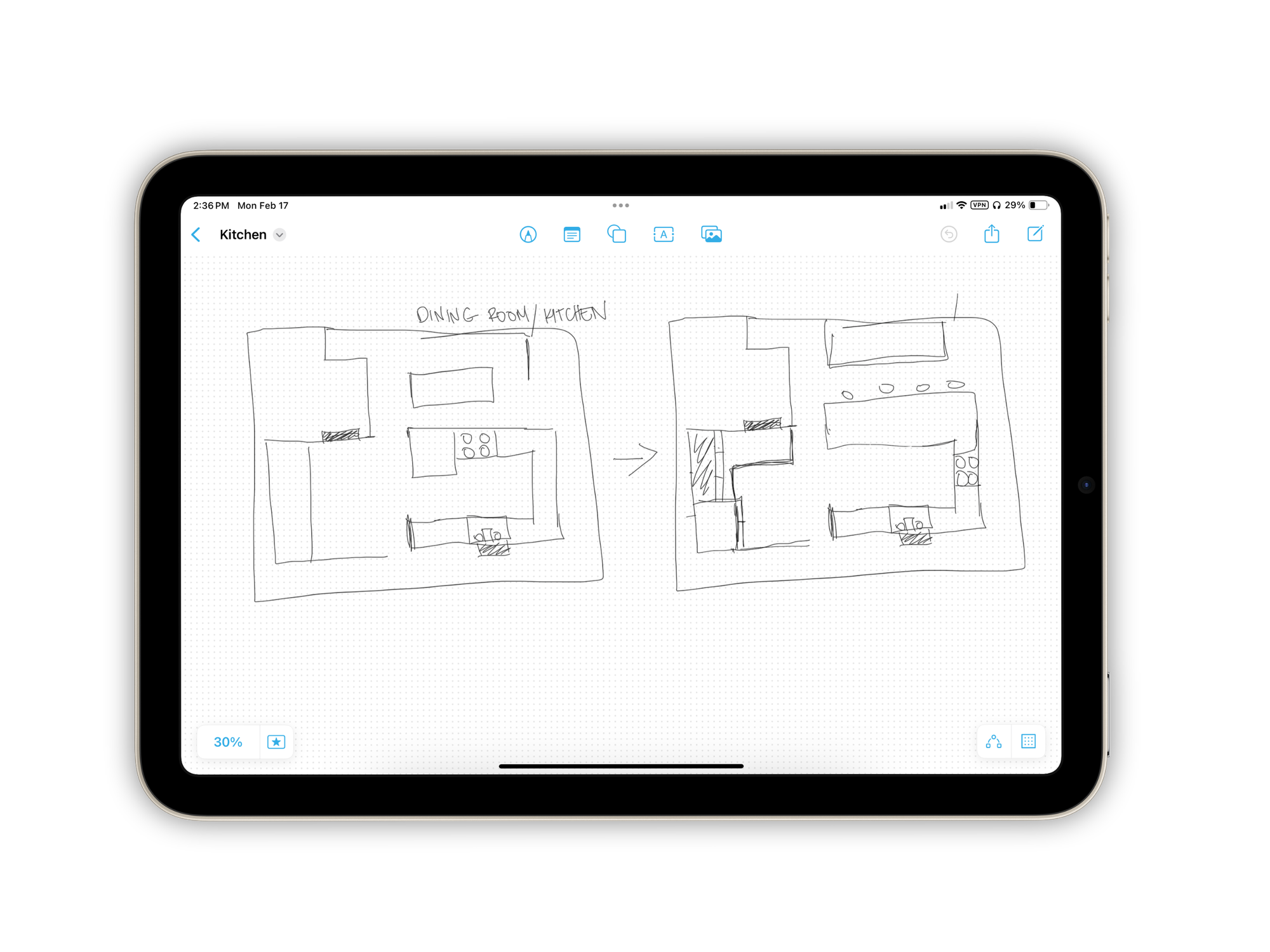
The other app I have been using more is Freeform, I was using it with my wife recently to sketch out some ideas for remodeling our kitchen area. I also used it a bit to draw out some ideas for my desk setup at home (which I will be sharing with you more).
The Apple Pencil pretty much is used on my iPad Mini more than my iPad Pro. If I get my dream device, the M4 Pro with a Nano-Texture display, I will probably get an Apple Pencil Pro for it but for now the USB-C Apple Pencil is just fine for my needs.
Mini Writing Workstation
For the iPad Mini, I also purchased an iClever keyboard and trackpad. I haven’t used it too much, but it is nice to have when I am out and about and have a place to write or work on something. I can Remote Desktop to my work PC from both my iPads so sometimes in a pinch at work I can work on something from the iPad Mini which is pretty convenient.
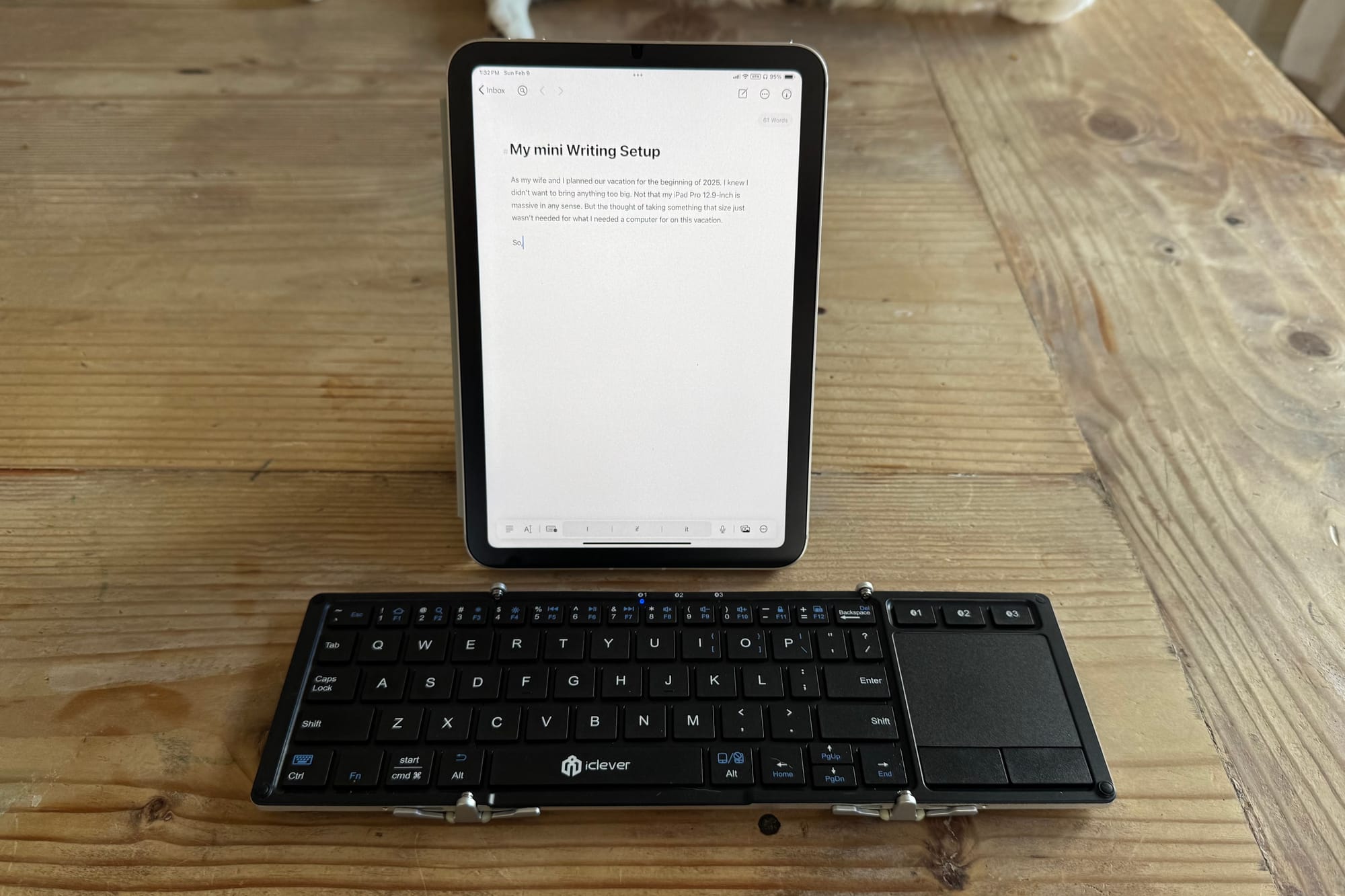
I bought it specifically for writing, though, and while on the cruise, I did write for a decent amount of time. This post was partially written on that tiny keyboard on the iPad Mini. I also have a Pikata case for the Mini, so I am able to angle it in portrait mode to have a tall area for Ulysses, which is better than nothing. I could just use the on-screen keyboard, which I have, but sometimes even a tiny keyboard is really nice to have.
Conclusion
As you can see, I can go on and on about the iPad Mini. It is such a fantastic device to do whatever you want. I really do think that iPadOS makes it so great; having such a powerful OS with the same great apps you can get on a larger iPad makes it so versatile.
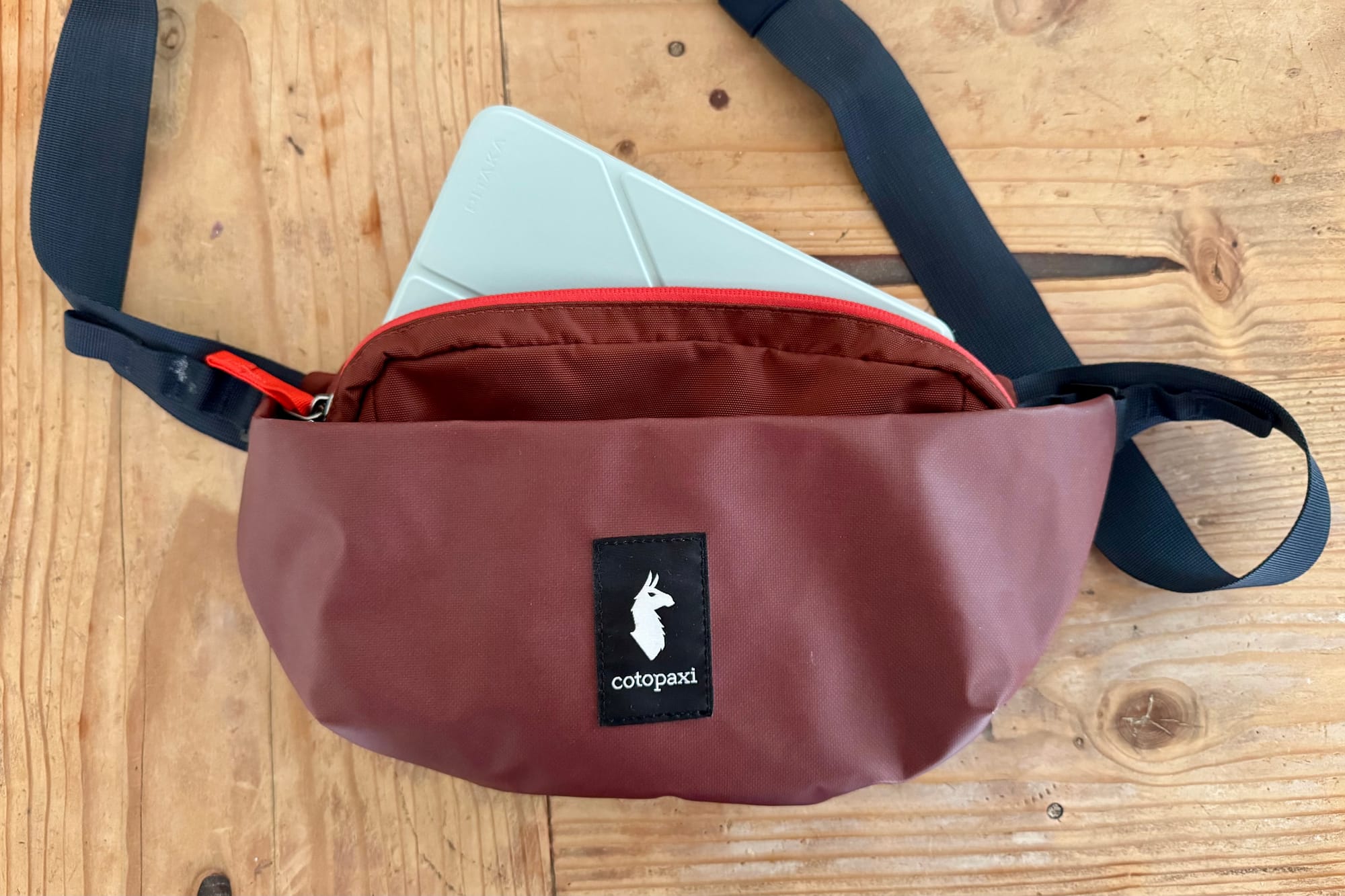
No, the iPad Mini doesn’t have Stage Manager, and it is probably missing other features that I would get on a larger iPad Pro, but that is no big deal. Stage Manager is great on my iPad Pro, and I don’t need it on my smaller iPad. Just like I don’t need certain features on my iPhone.
The iPad Mini has become a device I always have with me, even if I have my iPhone. Not only has this helped me read more, but I also feel like I have a mini supercomputer on me at all times that provides a better experience for some tasks than doing them on my iPhone.
And because I have a larger iPad Pro at home or in my backpack for when I need to really push iPadOS, it leaves the Mini to just be my everything else device — taking the pressure off and allowing me to just have fun.

